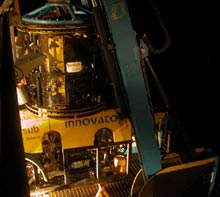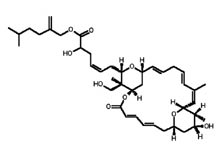Smiles Around the Room!
September 10, 2003
Gary K. Wolfe
Marine and Environmental Education
Eau Gallie High School
Rollins College, Brevard, FL
Taconya D. Piper
NOAA Office of Ocean Exploration
During the past two days, we experienced the Innovator's first and second collection dives at a site known as Pulley Ridge. To the scientists on board, this site is better known as "Forcepia-land" because of the vast amount of the orange-red sponge, Forcepia, which can be found in this area.
While watching the live video feed from the dry lab, Dr. Reed and the other scientists from Harbor Branch Oceanographic Institution (HBOI) view the video monitor with intense concentration. On the screen are soft sediments, starfish, pencil sea urchins and bottom fish. Then suddenly, the scientists begin to smile. Other HBOI veterans, who have been with Doctors Wright, Pomponi, and Reed, move closer to the monitor. A sponge! The small, orange-colored sponge is about 4 in long encrusted with some epibionts (an organism that lives on top of another organism). To me it looks like an ordinary sponge, but to the scientists on board it is like finding gold.
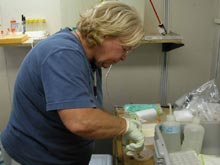
Jane Thompson of HBOI prepares a sample of Acarnus sp. for DNA extraction.Click image for larger view.
To any casual bystander, the excitement expressed by the scientists is very strange. To the trained eye, however, it is understandable why a small sponge in the middle of a sand flat could cause such excitement. The scientists hope it is the sponge Forcepia, which will be initially identified on board the ship and then positively identified back at the labs at HBOI. Forcepia produces a series of compounds called lasonolides, which exhibit promising biomedical properties for the treatment of pancreatic cancer. The main objectives of the next two dives are to collect as much Forcepia as the sub can handle in its collection boxes. The more Forcepia the scientists collect, the more samples they can use to conduct various biomedical experiments.
As we watch the video monitor, a titanium arm extends outward from the Innovator ROV (remotely operated vehicle) with a device known as a clamshell sampler, which is used to collect samples of sediment and various sponge species. As we continue to watch, the arm extends out and carefully grabs an orange sponge. Applause erupts from one of the HBOI scientists, which signals the beginning of smiles all around the room. The ROV has successfully surveyed and retrieved benthic samples from the sea floor. What a relief to all!
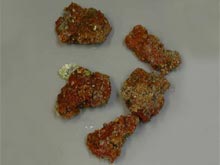
One of the unexpected finds during the first dive was this Acarnus sp. The science crew had never collected this sponge before, and even though it is not the desired Forcepia, the sponge will be tested to determine if any useful products can be isolated. Click image for larger view.
After a number of hours surveying and collecting samples along the sandy bottom habitat, the science team decided it was time to bring the Innovator back to the deck of the ship to process the samples. The HBOI science crew, the NOAA Ocean Exploration team, and a few of the Sonsub, Inc. technicians gathered in the wet lab to view the collected samples. It was amusing to watch all of these people crammed into a tiny room to view a few fist-sized orange sponges.
After careful examination of the sponge and one of its spicules under a microscope, it was determined that we did not collect any samples of the desired Forcepia, but rather, a closely related species known as Acarnus sp. Though this was not the sponge we were hoping for, we still processed the sponge for DNA analysis and cell culture, and prepped other samples for future testing to be conducted in the labs at HBOI. This was the first time this team of scientists recovered Acarnus sp., which is bright orange in color just like Forcepia. Even though this sponge was not the sponge of interest, the scientists will attempt to determine if any useful compounds can be isolated from Acarnus sp., and if the sponge can be useful in similar biomedical studies.
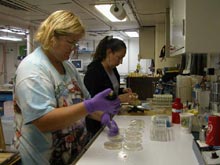
Kathleen Janda (left) and Tara Pitts (right) of HBOI place the Acarnus sp. on Petri dishes for cell culture. Click image for larger view.
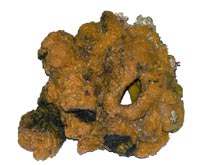
Collected on the second dive, this sponge, from the family Verongida, will be the subject of rigorous experimentation to determine if any useful biomedical products can be isolated from it. Click image for larger view.
During the second dive at "Forcepia-land" on Wednesday, September 10, we still didn't find any Forcepia, although we collected sponges from the order Axinellida and the families Desmapsamna, Verongida, and Petrosididae. These samples will be processed similarly to the Acarnus we found on the first dive, in an attempt to isolate useful compounds for biomedical research. Maybe one day, these unexpected finds will lead to new frontiers in biomedical research.
It is late now, and everyone seems drained and ready to sleep. Everyone has worked incredibly hard over the past few days, and will sleep well knowing that the Innovator has accomplished a great deal during its first two dives. We ending this day with a smile, for we are hopeful that tomorrow will be an even more productive day.
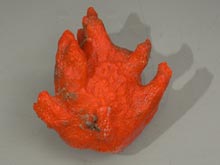
The sponge Forcepia is the source of the lasonolides. During the expedition we will collect specimens to continue our work on development of the lasonolides as new treatments for cancer. Click image for larger view.
Lasonolides
Amy E. Wright, Ph.D.
Co-Principal Investigator, Gulf of Mexico Expedition
Director, Division of Biomedical Marine Research (DBMR)
Harbor Branch Oceanographic Institution
The lasonolides are a series of exciting compounds, produced by the sponge Forcepia, with anticancer potential which were discovered by scientists at HBOI in 1994. These compounds are very potent and show especially promising properties for the treatment of pancreatic cancer. One of the interesting things about the lasonolides is that they kill cancer cells in a different way than most other cancer drugs. Exactly how they kill cancer cells is not yet defined, but we are working very hard to answer this question.
The first two dives of this mission will occur at a site about 100 nautical miles Southwest of Sanibel Island, Florida. At this site, the sponge, which produces the lasonolides grows in good abundance. We often refer to this location as "Forcepia-land". The sponge lives in about 230 feet of water on a sand covered bottom. This is somewhat unusual because most sponges prefer to attach to firmer substrates: for example rocks. Forcepia on the other hand, grows in the sand and actually incorporates sand into its tissue. This seems to provide it with a firm anchor into the soft bottom and keeps it from being "blown" around by currents.
We have quite a few projects on Forcepia. In addition to defining how it kills cancer cells, we are also trying to find ways of producing large amounts of the compounds. To do this we are trying to grow the sponge's cells in cell culture flasks; we have a small "aqua-farm" of Forcepia in the Florida Keys and we are trying to clone the genes that make the lasonolides.
As a part of our cell culture experiments we will extract RNA (ribosomal nucleic acids) from cells treated with the lasonolides and then analyze them using gene microarrays. The gene microarray analysis will tell us something about which genes are expressed by cells in response to the lasonolides. With this information, we hope to develop better culture methods for the sponge. It may also help us to understand how the compounds kill cancer cells.
Specimens will also be collected for aquaculture e.g. "sponge-farming" experiments. In our first "in-the-sea" sponge farm, we determined that the sponge grows best when in contact with sand. On this expedition we will determine what types of food it eats and attempt to grow the sponge in "closed-system" (e.g. recirculating) aquaculture tanks.
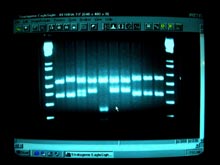
Gel electrophoresis allows us to separate pieces of DNA. The DNA can be stained with ethidium bromide and then detected using ultraviolet light. The bright "bands" on this gel are DNA fragments produced by restriction enzyme digestion. The band to the far side are DNA size markers. Click image for larger view.
The lasonolides belong to a class of compounds known as "polyketides". Polyketides are synthesized by the condensation (joining) of smaller organic molecules such as acetate or malonate to form large molecules. The genes responsible for the synthesis of polyketides are clustered together on the genome (e.g. they are contiguous). Large pieces of DNA can be extracted and then cut into smaller pieces which are cloned into an "expression vector". These pieces of DNA make up a "gene library" which we can analyze for the presence of particular genes of interest. Our long-term goal is to clone the genes of interest into a microorganism such as E. coli, which is easier to grow. This will then give us an "engineered organism" which will function as a small chemical factory to produce a large supply of the compounds. During the mission, we will isolate and purify large molecular weight DNA for preparation of a gene library from Forcepia.
Sign up for the Ocean
Explorer E-mail Update List.






















